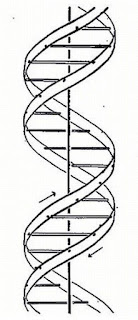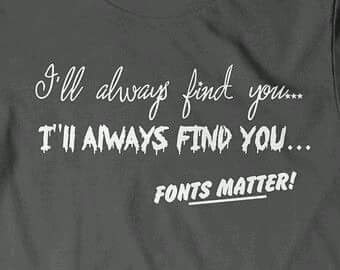Latest modern science | Link roundup for May 2016 - Si Bejo Science
link roundup posters on screensMatthew wins for best poster design cartoon this month:
You can see more of his cartoons at Errant Science. His inspiration for this one?
Just to drive the point home, let me say: Writing text in a 2 point font on a poster is dumb. Do not do that.
James Hamblin, writing for The Atlantic, has a fascinating article about using colour to increase the readbility of text. Here�s an example, where colour is used as a cue to tell you what the next line is:
This specific example is from a company called BeeLine. They have plugins for Chrome for the web and PDFs. Here�s this blog viewed in Beeline:
I haven�t had success with reading my PDF reprints in BeeLine colour yet.
The Atlantic article suggests there are many more possibilities to improve the reading experience beyond what we have learned from the printed page. I would not recommend trying it for a poster quite yet, because the unfamiliarity might be confusing or annoying for readers. A browser plugin is not like a poster: the reader has the control in the former, but not the latter.

The Atlantic article also mentions the Microsoft typeface Sitka (sample at right):
I might just try Sitka on my next poster.
I really enjoyed this blog post by Stephen Few about 3-D graphs. You know, like this one:
Not only is the article thoughtful, there are some great one-liners:
And I like the conclusion:
Today in �Colour is a subtle thing,� Ed Hawkins looks at how �rainbow� coding for maps led to some incorrect interpretations.
Hat tip to Rob Simmon.
I�ve followed the fate of �dynamic posters� at the Neuroscience meeting since they were first announced. I think a fee to have one is new:
And the question remains how many people are genuinely using the format to its fullest:
Michael Hoffman is looking for new graphics software:
In the replies to this tweet, people bring up xfig, Sketch, Drawio, Omnigraffle, Canvas, Graphic, and Pages.
QUote of the moment:
Hat tip to Ellen Lupton.
Another university, another new logo freak-out.
You can see more of his cartoons at Errant Science. His inspiration for this one?
Just looked at a draft of a poster, there was text in size 2 point�
Just to drive the point home, let me say: Writing text in a 2 point font on a poster is dumb. Do not do that.
James Hamblin, writing for The Atlantic, has a fascinating article about using colour to increase the readbility of text. Here�s an example, where colour is used as a cue to tell you what the next line is:
This specific example is from a company called BeeLine. They have plugins for Chrome for the web and PDFs. Here�s this blog viewed in Beeline:
I haven�t had success with reading my PDF reprints in BeeLine colour yet.
The Atlantic article suggests there are many more possibilities to improve the reading experience beyond what we have learned from the printed page. I would not recommend trying it for a poster quite yet, because the unfamiliarity might be confusing or annoying for readers. A browser plugin is not like a poster: the reader has the control in the former, but not the latter.

The Atlantic article also mentions the Microsoft typeface Sitka (sample at right):
(Microsoft researcher Kevin Larson�s) team also recently launched a new font that was designed for the best possible readability. Called Sitka, it went through a multistep, iterative design-test process. Each letter was changed and adjusted to maximize ease of reading � as opposed to most other fonts, which are made to mimic typefaces that existed in print media. �Times New Roman was designed to work very well with the technology of the era,� Laston explained. (I asked him if he has, then, created the most legible font in history. He said he �wouldn�t go that far.�)
I might just try Sitka on my next poster.
I really enjoyed this blog post by Stephen Few about 3-D graphs. You know, like this one:
Not only is the article thoughtful, there are some great one-liners:
(P)oking holes in Edward Tufte�s work in particular now qualifies as a competitive sport.
And I like the conclusion:
It is important to realize that what is often claimed by infovis researchers is just plain wrong, due to bad science. I wholeheartedly agree... that we should not accept any data visualization principles or practices as gospel without confirming them empirically. However, we should not throw them out in the meantime if they make sense and work, and we certainly shouldn�t reject them based on flawed research.
Today in �Colour is a subtle thing,� Ed Hawkins looks at how �rainbow� coding for maps led to some incorrect interpretations.
Hat tip to Rob Simmon.
I�ve followed the fate of �dynamic posters� at the Neuroscience meeting since they were first announced. I think a fee to have one is new:
$150 fee to present a Dynamic Poster#SFN16? pass. - Drugmonkey
And the question remains how many people are genuinely using the format to its fullest:
80% of those are just people who wanted to give a talk. Rarely actually need video. - Dr. Becca
Michael Hoffman is looking for new graphics software:
Wish I had something that made it as easy to make diagrams as PowerPoint but still publication quality like Illustrator.
In the replies to this tweet, people bring up xfig, Sketch, Drawio, Omnigraffle, Canvas, Graphic, and Pages.
QUote of the moment:
�Typography is frozen sound.��Ran Zheng
Hat tip to Ellen Lupton.
Another university, another new logo freak-out.











































